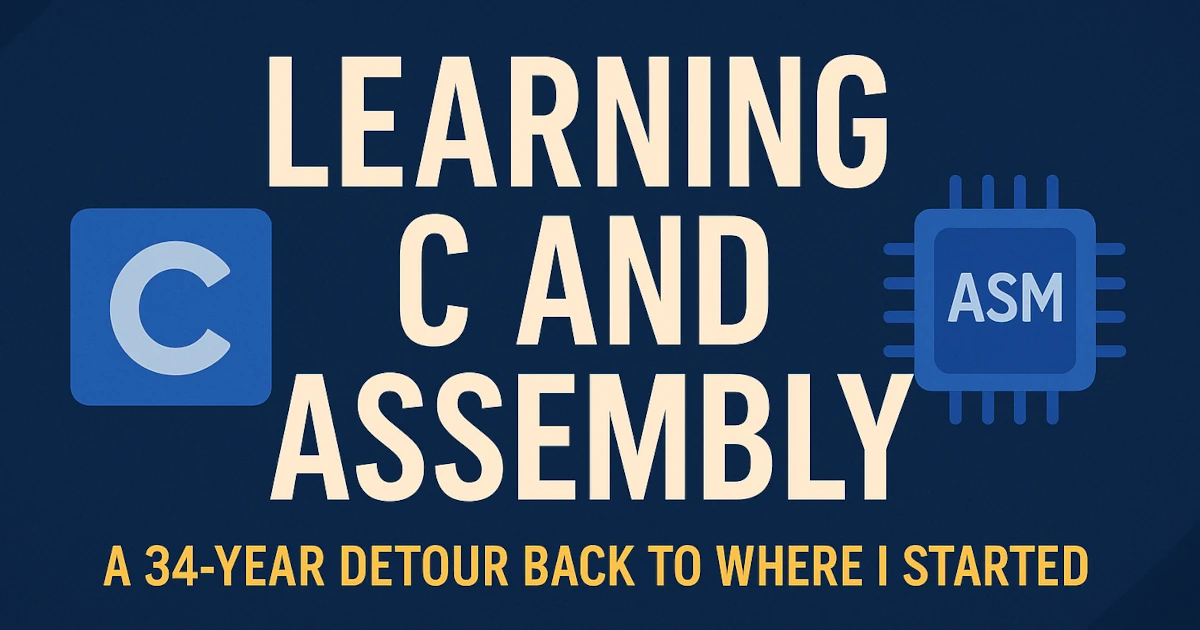Learning C and Assembly: A 34-Year Detour Back to Where I Started
After 34 years, I'm finally learning C and Assembly—the languages I set out to explore as a kid. Join me as I revisit low-level programming with weekly updates, hands-on projects, and lessons from a tech lead's perspective.
In 1989, my dad brought home our first family computer for Christmas. I was 9 years old and immediately obsessed. I dove into GW-BASIC, writing simple programs and trivia games, not because anyone told me to, but because I felt like I had to. It felt like magic.
When I was 11, one of my dad’s friends who worked as a programmer told me, “If you want to get serious, you should learn C.” So my dad bought me a book and a C compiler. I wish I remembered which one. But not long after, Visual Basic hit the scene and, like many kids discovering drag-and-drop interfaces for the first time, I was pulled in that direction.
Then came the modem. BBSs. Building my own BBS. Then the web. And the rest, as they say, is history.
Fast forward to 2025. I am a tech lead at a software company. Most of my day is spent mentoring junior developers, reviewing code, and writing specifications. I am proud of that work, but I miss the feeling of exploring how computers really work under the hood.
So I have decided to finally return to that path I almost took 34 years ago.
I am going to learn C. And Assembly. For real this time.
This is not about career growth or job requirements. It is about curiosity, craftsmanship, and closing a loop I left open as a kid.
If you are also interested in understanding how computers work at a lower level or just want to follow along, I will be sharing everything I learn on this blog. Mistakes, insights, weird rabbit holes, and all.
Follow along. Ask questions. Or even better, join me.
Why C and Assembly?
C is still one of the most important programming languages in the world. It is close to the metal, but still readable. It forces you to think about memory, performance, and structure in ways higher-level languages often abstract away. Assembly takes it one level deeper, giving you a direct line into the CPU and system architecture.
Learning both feels like getting the keys to the engine room.
As someone who often writes analysis documents and works with developers across the stack, I want to deepen my technical foundation and I want to do it with the tools that shaped modern computing.
The Learning Plan
Here is how I am approaching this:
- C Programming: I am starting with the C path on Pluralsight to get structured learning and practice.
- Assembly: I will begin with x86 architecture and simple 16-bit programs to understand how code interacts with hardware.
- Hands-on Projects: Expect small, focused programs, everything from console apps to low-level experiments that might never see production but will teach me something useful.
- Weekly Blog Updates: I will post progress, code snippets, and reflections, especially the “aha” moments and the things that do not go as planned.
- Bonus Skills: I will also be sharpening my analysis and documentation skills along the way, since clear thinking and communication matter just as much as code.
What to Expect
This series will not be polished tutorials or clickbait. It will be a mix of:
- What I learned that week
- Code examples (good and bad)
- Concepts that clicked (and those that did not)
- How this helps me as a developer and technical lead
If you have ever wanted to learn C or Assembly but did not know where to start, this is a good time to jump in. I am learning from scratch just like you might be, and I will be sharing the whole journey, not just the highlights.
A Quick Ask
If this sounds interesting, bookmark the blog or follow me on social. And if you are learning C or Assembly too, send me a message. Let us learn together.
This blog runs on coffee, YAML, and the occasional dad joke.
If you’ve found a post helpful, you can
support my work or
☕ buy me a coffee.
Curious about the gear I use? Check out my smart home and homelab setup.
